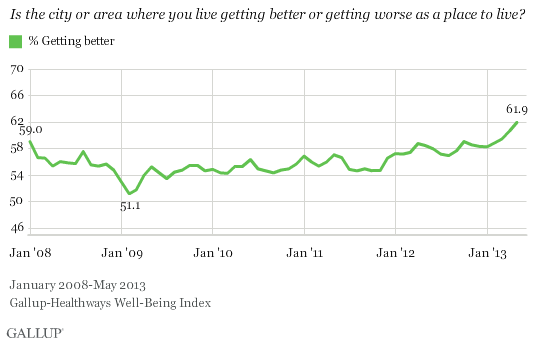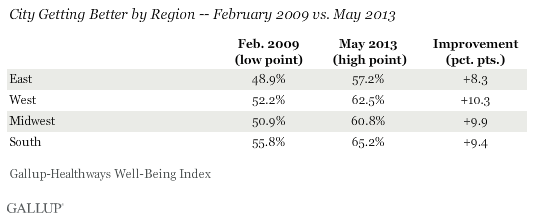WASHINGTON, D.C. -- More Americans now say the city or area where they live is getting better -- 61.9% -- than have at any time since January 2008. Americans' optimism about where they live has been steadily increasing since January of 2013.

Americans were less optimistic about the future of the cities where they live during the economic downturn in 2009, with the percentage saying their city is "getting better" falling to a low of 51.1% in February 2009. Their outlook remained relatively depressed in 2010 and 2011, but began to recover in 2012.
City Optimism Up Across All Regions, Remains Best in the South
Americans living in the South are the most likely to say the city where they live is getting better, as was the case in February 2009 when city optimism was at a low point nationwide. However, Americans in all regions of the country are now much more optimistic about where they live. Optimism increased the most in the West since February 2009 and increased the least in the East. Americans in the East are the least optimistic about their cities in 2013, as was the case in February 2009.

Bottom Line
Americans' optimism about the city where they live climbed to a new high at the same time that their and their did. Workers nationwide are also reporting some of the best numbers in years. Together, these metrics reveal that Americans are at least feeling like economic conditions nationally, locally, and individually are improving.
About the Gallup-Healthways Well-Being Index
The Gallup-Healthways Well-Being Index tracks well-being in the U.S. and provides best-in-class solutions for a healthier world. To learn more, please visit .
Survey Methods
Results are based on telephone interviews conducted as part of the Gallup-Healthways Well-Being Index survey May 1-31, 2013, with a random sample of 15,735 adults, aged 18 and older, living in all 50 U.S. states and the District of Columbia.
For results based on the total sample of national adults, one can say with 95% confidence that the margin of sampling error is 卤1 percentage points.
Interviews are conducted with respondents on landline telephones and cellular phones, with interviews conducted in Spanish for respondents who are primarily Spanish-speaking. Each sample of national adults includes a minimum quota of 50% cell phone respondents and 50% landline respondents, with additional minimum quotas by region. Landline telephone numbers are chosen at random among listed telephone numbers. Cell phones numbers are selected using random digit dial methods. Landline respondents are chosen at random within each household on the basis of which member had the most recent birthday.
Samples are weighted to correct for unequal selection probability, nonresponse, and double coverage of landline and cell users in the two sampling frames. They are also weighted to match the national demographics of gender, age, race, Hispanic ethnicity, education, region, population density, and phone status (cellphone only/landline only/both, cellphone mostly, and having an unlisted landline number). Demographic weighting targets are based on the March 2012 Current Population Survey figures for the aged 18 and older U.S. population. Phone status targets are based on the July-December 2011 National Health Interview Survey. Population density targets are based on the 2010 census. All reported margins of sampling error include the computed design effects for weighting.
In addition to sampling error, question wording and practical difficulties in conducting surveys can introduce error or bias into the findings of public opinion polls.
For more details on Gallup's polling methodology, visit .
